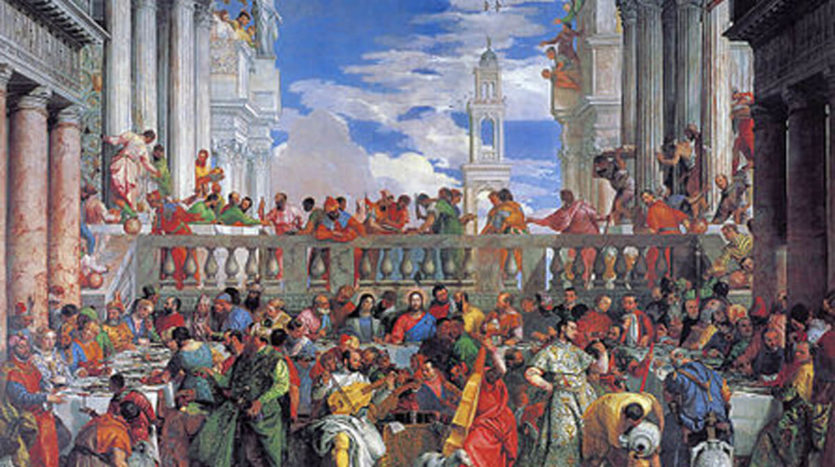The Wedding at Cana: A Banquet That Shakes Up the Codes!
The Wedding at Cana was commissioned in 1562 by a Benedictine from the monastery of San Giorgio Maggiora in Venice to decorate the refectory. Surprisingly, the contract specifies that Paul Véronèse, the painter, “shall be allowed to fit as many people as it is feasible to fit within the picture.” After Napoleon’s first Italian war and the signing of the Treaty of Campoformio, the Muséum central des arts – now the Louvre – gained control of it in 1798, it became French patrimony. A look back at the details of a magnificent work in every way seen.
An extraordinary masterpiece for a miraculous story
Paul Véronèse’s work never fails to surprise, first and foremost because of its size: 6.77 by 9.94 meters, making it one of the most striking ancient paintings in the Louvre’s collection, especially in France.
This size allows for a total of 130 colorful characters. The scenario portrayed is from a New Testament tale. Jesus and his mother Mary are invited to the wedding and sit in the middle, surrounded by disciples, kings and aristocrats, commoners and slaves, instead of the bride and groom. The bride and groom are seated at the far end of the table, relegated?
On this occasion, Jesus performs his first miracle, turning water into wine when it runs dry, while surrounded by his blazing halo. The servant may be seen pouring the wine from a stone jar usually filled with water into a pitcher designated for the wine at the bottom right of the picture. The steward of the house, dressed beautifully in silk, stares in astonishment at the glass of wine given to him by his assistant accountant, who is easily identified by his red staff. This individual is fully aware that he did not pay for the wine.
At this period, anachronism was prevalent, and we see Jesus in a scene and surrounded by people from the 15th century. Contemporaries of the artist, such as Titian and Bassano, are well-known among them.
An interpretation in questioning
At first sight, Paul Veronese’s art seems to be intended to shock Christian values. The appearance of Jesus and Mary in the middle of such a diverse and colorful crowd calls into question the respect given to them, particularly because the piece is meant to hang in a monastery’s common room.
A closer examination reveals that Jesus is the true focal point of the scene, and the only figure who looks directly at the viewer with a contemplative gaze. All of the painting’s convergent lines point back to Jesus, who stands in the middle yet seems to be outside the scene, an observer who asks us about our connection to the scenario.
The painter also paid attention to religious beliefs in form: if the guests on the left eat a lot, the monks on the right have empty plates and must not have eaten much, indicating that they have not succumbed to gluttony.
Finally, the sky takes up a significant portion of the picture, as if to suggest that the important is located elsewhere other than at the social gathering. The existence of genuine love in the smiles given by the visitors on stage may be questioned by the bride and groom, who seem frozen in the middle of other heated people. A denunciation of superficiality and an invitation to return to the simple things come to mind.
The symbol of power and decadence
The Veneto was, at the time, the most sophisticated location in the West, which Paul Véronèse seems to wish to emphasize, not only via the lavish celebration but also through other means.
Every element of the picture emphasizes the height of Venice’s supremacy as a center for Mediterranean trade and a gateway to the Orient, as well as a manufacturer of the best glassware. Characters wearing turbans, a parrot, and an African servant are all present at the dinner, indicating the city’s remote influence. The Murano glassworks that welcome the miracle wine are clearly of the highest quality.
Other elements indicate the fall of Venice, which had already started in the period, among the musicians present in the foreground and possible to depict Paul Veronese himself as well as his younger brother, surrounded by the aforementioned Venetian artists.
The flowing hourglass seems to represent the fact that extravagant celebrations will have to come to an end shortly. Dogs, on the other hand, seem to be a sign of sadness.
When this view is combined with Jesus’ miracle, it is possible to believe that Cana represents the beginning of the disaster: the end of Venetian dominance in the fifteenth century, and the first milestone on the road to the cross for Jesus after he has shown his miraculous abilities.
Les Noces de Cana seems to be a significant work for all of Christendom, since it is shown in the same chamber as the Mona Lisa at the Louvre. The painting’s brilliance has been restored thanks to a recent repair, which was carried out immediately on site due to the painting’s size, which made transportation impossible. Take a look at it!


